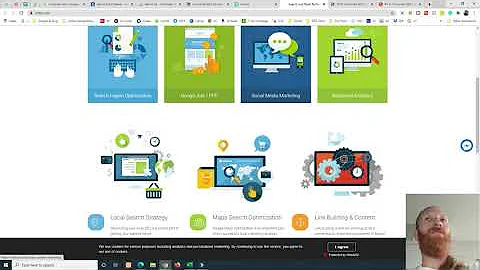Protect Your Website: Disavow Backlinks with Google Search Console and Ahrefs
Table of Contents
- Introduction
- Identifying Crappy Backlinks
- Accessing the Disavow Links Tool
- Organizing Backlinks by DR
- Filtering Backlinks by Date
- Disavowing Backlinks at the Domain Level
- Exporting the Disavow List
- Uploading the Disavow List to Google Search Console
- Repeating the Disavow Process
- Conclusion
Introduction
In this article, we will explore how to disavow crappy backlinks that may harm your website's search engine rankings. We will specifically focus on using the disavow links tool in Google Search Console. Crappy backlinks can be detrimental to your website's performance and may lead to penalties from search engines. By disavowing these backlinks, you can protect your website's reputation and improve its visibility in organic search results. So, let's dive in and learn how to identify and disavow these harmful backlinks effectively.
Identifying Crappy Backlinks
Before we can disavow backlinks, we need to identify which ones are considered "crappy." Crappy backlinks usually come from low-quality websites or spammy sources. They can be easily recognized by their low Domain Rating (DR) and irrelevance to your website's niche. Tools like Ahrefs can help with identifying and analyzing backlinks to determine their quality. By thoroughly analyzing your backlinks, you can pinpoint the crappy ones that need to be disavowed.
Accessing the Disavow Links Tool
To begin the disavow process, access the disavow links tool in Google Search Console. It's essential to have your website added as a property in Search Console before proceeding. Once you are in the dashboard, locate and click on the disavow links tool. This will open a new tab where you can start selecting and disavowing backlinks.
Organizing Backlinks by DR
To make the disavow process more manageable, you can organize backlinks by their Domain Rating (DR). Sorting them from lowest to highest DR allows you to prioritize disavowing the lowest quality backlinks first. By focusing on the lowest DR backlinks, you increase the chances of eliminating the most harmful backlinks.
Filtering Backlinks by Date
Another method to organize backlinks is by filtering them based on the date they were acquired. By sorting backlinks chronologically, you can identify recent influxes of backlinks and assess their quality. This method helps you stay updated on the current state of your backlink profile and disavow any new crappy backlinks promptly.
Disavowing Backlinks at the Domain Level
When disavowing backlinks, it's recommended to disavow them at the domain level. Disavowing at the domain level ensures that any backlink from that domain is considered invalid by search engines like Google. This approach provides broader protection against crappy backlinks from those domains. By selecting the backlinks you want to disavow and clicking the "disavow domains" button, you can eliminate multiple backlinks in one go.
Exporting the Disavow List
After selecting and disavowing the backlinks, it's important to export the disavow list for future reference. By clicking the "export" button, you can save the list as a text file. This file contains all the domains that you have disavowed. Having this list saved allows you to keep track of the disavowed backlinks and helps in the re-upload process.
Uploading the Disavow List to Google Search Console
To complete the disavow process, you need to upload the disavow list to Google Search Console. Access the disavow links tool in Search Console and click on the upload button. Choose the text file you previously exported and upload it. This will replace the previously uploaded disavow list and ensure that the newly disavowed backlinks are accounted for.
Repeating the Disavow Process
As crappy backlinks continue to pour in, it's crucial to periodically repeat the disavow process. Monitor your backlinks for any influxes, as these can occur in waves that may last for weeks or even months. By keeping an eye on your backlinks and disavowing any new crappy backlinks promptly, you can maintain a clean and healthy backlink profile.
Conclusion
Disavowing crappy backlinks is an essential aspect of maintaining a healthy backlink profile and protecting your website's search engine rankings. By effectively identifying and disavowing these harmful backlinks, you can avoid penalties and improve your website's visibility in organic search results. Remember to periodically monitor your backlinks and repeat the disavow process as needed to ensure optimal results.
Highlights
- Learn how to identify crappy backlinks and protect your website from penalties.
- Access the disavow links tool in Google Search Console to disavow harmful backlinks.
- Organize backlinks by Domain Rating (DR) and date to prioritize disavowal.
- Disavow backlinks at the domain level for broader protection.
- Export and upload your disavow list to Google Search Console for effective management.
- Repeat the disavow process periodically to maintain a healthy backlink profile.
FAQ
Q: What are crappy backlinks?
A: Crappy backlinks are low-quality or spammy links that can negatively impact a website's search engine rankings.
Q: How can I identify crappy backlinks?
A: Crappy backlinks can be identified by their low Domain Rating (DR) and their irrelevance to the website's niche.
Q: Why should I disavow backlinks?
A: Disavowing backlinks helps protect your website from penalties and improves its visibility in organic search results.
Q: Should I disavow backlinks at the domain level or URL level?
A: It is recommended to disavow backlinks at the domain level for broader protection.
Q: How often should I repeat the disavow process?
A: It is advisable to periodically repeat the disavow process to stay updated on the quality of your backlinks.







